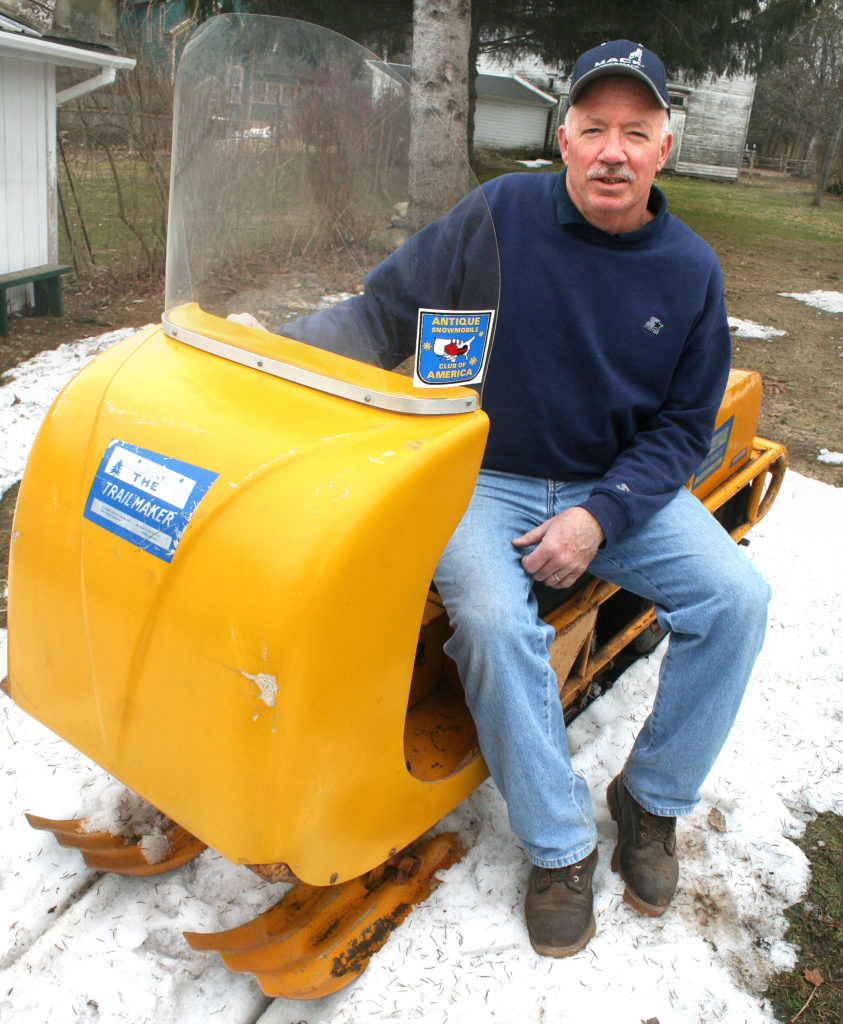MOSHIER REPRESENTS NATIONAL CLUB
Richfield Man Keeps
Antique Trail Makers
In The Public Sphere
By JIM KEVLIN • Special to www.AllOTSEGO.com

and other vintage snowmobiles alive. (Jim Kevlin/AllOTSEGO.com)
RICHFIELD SPRINGS – In the early 1960s, as Bob Moshier tells it, if you bought three snowmobiles, you qualified to be a dealer.
Looking for a year ’round use for the family’s Otsego Lake marina just north of the Otsego-Springfield town line, William Thayer picked up three Trail Makers.
“The first time someone passed Willie on a Ski-Doo, he bought a Ski-Doo,” said Moshier.
The three Trail Makers – one unused – sat in the back of a barn on property that’s now part of the
The older brother passed away in 1984. The younger Thayer brother, Rufus, was a friend of Moshier’s grandfather, and the older and younger man started turkey hunting together and became close friends.
In 1995, Rufus – wanting to put the machines back in use – offered Bob Moshier, then a young father, the Trail Makers, which by then had been sitting untouched for decades.
“I didn’t have the time and space for them,” said Moshier. Still, he wrote down the markings on one of the machine’s decals: “The Trail Maker – Abe Mathews Manufacturing Co., Hibbing, Minn.”
The next week, his curiosity growing, Moshier picked up the Trail Makers and stowed them in the barn behind his home on the west end of Richfield Springs.
His love affair with antique snowmobiles had begun.
Today – 25 years later, Moshier is Eastern Regional director for ASCA, the American Council of Snowmobile Associations – its slogan, “Uniting the Snowmobile Community.”
The sole duty, he was told, is raising the profile of antique snowmobiles, a 12-month interest for ASCA members. “Shows!
You could go to one every weekend,” he said.
While the ASCA is based in Lansing, Mich., and while Mike Meagher, the president of the VSCA – the Vintage Snowmobile Club of America – holds sway from Grey Eagle, Minn., the largest show Moshier’s ever attended was last Aug. 3-4 in Lowville.
Some 100 miles north of Richfield Springs, the VSCA put on its 14th annual Vintage Snowmobile National Show, filling the Lewis County Fairgrounds with some 140 exhibitors. Once a year, Moshier contacts a local news outlet to keep getting the story out.
So the other day, he rolled one of the Trail Makers out of his barn onto one of the few remaining snow drifts in his backyard. (Although knowing the weather around here, we still could get another snowmobile-enabling snowstorm.)
As Moshier pointed out, “it’s very simple.” For instance, “the skis were culvert pipes.” His Trail Makers’ skis are unpainted at the bottom, indicating they are early models.
The engine is a K161 7-horsepower Kohler – it was also used to power riding lawnmowers. And Moshier still has the original sparkplug. It’ll do the job, although he uses a contemporary sparkplug to save wear and tear on the original.
The Trail Maker’s advantage of simplicity; no computers: “You can work on it,” he said.
Once in hand, one thing led to another. Drilling down, Moshier discovered Abe Mathews Engineering primarily did work for iron mines in the nearby, and famed, Mesabi Range.
Iron mining went through periodic dips and, during one of them, Mathews’ mechanic John Howe sold his patent on his snowmobile to the company, which began producing the Trail Maker in the early 1960s.
In an article he wrote in 1999 for the ASCA’s magazine, Iron Dog Tracks, Moshier interviewed Gerald “Tony” Heald, who worked with Howe, who “described how the exclusive octagon drive unit was designed to vibrate snow out of the track, whereas Polaris and Artic Cat would get snow in the track belt and slip.”
The rear engine was another positive feature, creating a smoother ride, Heald told Moshier, who also recalled Ski-Doo’s trials with the first front-engine sled: It would burrow the vehicles into snowbanks. The engine had to be shifted to the back, at some expense to the company.
In the 1990s, Moshier was happy to show off his new acquisitions: He and son Bobby, now an engineer in the Rochester area, would use one Trail Maker to pull a trailer bearing another in the annual Richfield Springs’ Firemen’s Parade, an annual summer highlight.
(His wife, Robin, is current Richfield Springs mayor, and daughter Katie was an aide to state Sen. Jim Seward.)
It’s unknown to most of us driving up and down West Lake Road that we’re passing a historical vignette: In 1964, Willie Thayer used a sturdy Trail Maker to pull a NYTel cable across the ice, near Sunken Island.
When the ice melted, the cable sank to the bottom, and is still serving our communications needs today.

